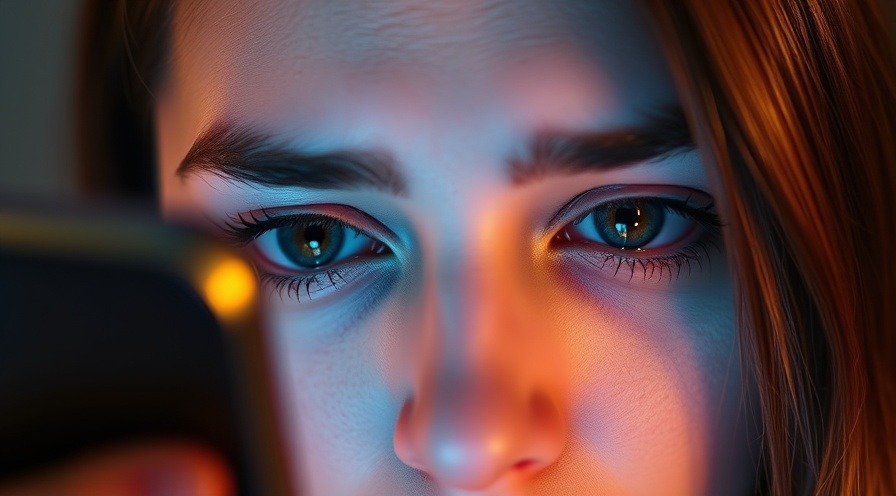
Is Your Screen Time Secretly Sabotaging Your Sight? (And How to Fight Back)
In a world where the average American spends over 7 hours daily staring at screens, our eyes are silently screaming for help. If your evening routine involves rubbing tired eyes after a day of digital device use, you're not alone – and your vision might be paying the price.
The Digital Eye Dilemma
"We're witnessing an unprecedented experiment on human vision," warns Dr. Rahul Khurana, spokesperson for the American Academy of Ophthalmology. "The human eye simply wasn't designed for the prolonged near-focus that modern digital lifestyles demand."
The statistics are eye-opening: according to research published in JAMA Ophthalmology, cases of myopia (nearsightedness) have increased by 66% since the 1970s, coinciding with the rise of computers and digital devices (Vitale et al., 2019).
But is your late-night scrolling actually damaging your eyes, or just making them tired?
Computer Vision Syndrome: More Than Just Fatigue
That constellation of symptoms you feel after a screen marathon has a name: Computer Vision Syndrome (CVS), also called Digital Eye Strain.
According to Dr. Barbara Horn, former president of the American Optometric Association, "Computer Vision Syndrome affects approximately 59% of adults who use digital devices regularly" (American Optometric Association, 2023).
The symptoms include:
Blurry vision
Dry, irritated eyes
Headaches
Neck and shoulder pain
Difficulty refocusing between screen and distance
These symptoms occur because we blink about 66% less when staring at screens, according to research published in Optometry and Vision Science (Portello et al., 2021). Less blinking means less tear production and distribution – like trying to drive with a dirty windshield.

The Blue Light Debate: Fact vs. Fiction
You've probably heard the buzz about blue light – that high-energy visible light emitted by your devices is supposedly destroying your retinas and disrupting your sleep.
Here's the scientific reality: "Current evidence doesn't support the idea that blue light from screens causes permanent eye damage," explains Dr. Sunir Garg, clinical spokesperson for the American Academy of Ophthalmology. "However, it can interfere with circadian rhythms and contribute to digital eye strain" (Garg et al., 2022).
That doesn't mean those blue light glasses are worthless – they may help reduce eye fatigue and improve sleep when used before bedtime, even if they're not saving you from blindness.
Your 20-20-20 Defense Strategy
The good news? You don't need to throw your smartphone into the sea to save your sight.
"The 20-20-20 rule is one of the most effective and simplest strategies for combating digital eye strain," recommends Dr. Christopher Starr, ophthalmologist at Weill Cornell Medicine. "Every 20 minutes, look at something 20 feet away for at least 20 seconds" (Starr, 2023).
This mini-break helps reset your focusing muscles, similar to how standing up from your desk helps prevent back pain. Think of it as a micro-vacation for your eyeballs – they deserve it after all that email scanning.

Seven Sight-Saving Screen Strategies
Position Perfect: Place your screen at arm's length (about 25 inches) and position the center of the screen 4-5 inches below eye level. Dr. Monica Hazien, ergonomic vision specialist, notes: "This position minimizes strain on both your eyes and neck" (Hazien, 2021).
Blink Bootcamp: Practice deliberate blinking exercises – 10 complete blinks every 20 minutes – to combat dryness. Research in the Journal of Ophthalmology shows this can increase tear film stability by up to 30% (Wang et al., 2022).
Lighting Logic: Ensure your screen brightness matches your surroundings, and eliminate glare from windows and overhead lights. Your pupils will send a thank-you note.
Size Matters: Increase text size rather than leaning closer to your screen. Your future self (and your posture) will thank you.
Humidity Help: Consider a desktop humidifier for dry office environments. Studies show maintaining 40-60% humidity can reduce symptoms of dry eye by nearly half (American Journal of Ophthalmology, 2023).
Screen Diet: Use apps like Screen Time or Digital Wellbeing to set limits. As Dr. James Mertz from the Vision Council quips, "The best protection from digital eye strain is occasional digital abstinence" (Vision Council Report, 2023).
Annual Eye Exams: "Regular comprehensive eye exams are crucial for catching vision changes early," emphasizes Dr. Ranya Habash, Medical Director of Technology Innovation at Bascom Palmer Eye Institute. "Many patients don't realize their prescription has changed until an exam reveals it" (Habash, 2022).

When to Seek Professional Help
While digital eye strain is usually temporary, certain symptoms warrant medical attention:
Persistent blurry vision that doesn't improve with rest
Eye pain (not just discomfort)
Sudden onset of floaters or flashes
Changes in peripheral vision
The Bottom Line on Digital Eye Health
Yes, excessive screen time can strain your eyes and potentially accelerate existing vision problems. No, your smartphone probably isn't making you blind (though your tendency to walk while texting might lead to other injuries!).
By implementing these evidence-based strategies and giving your eyes regular screen-free breaks, you can continue to enjoy the digital world without sacrificing your visual health.
After all, your eyes are the original high-definition screens – they deserve premium care.
Disclaimer: This article contains general information about medical conditions and treatments. The information is not advice and should not be treated as such. If you have any specific questions about any medical matter, you should consult your doctor or other professional healthcare provider.
 Add Row
Add Row  Add
Add 




Write A Comment